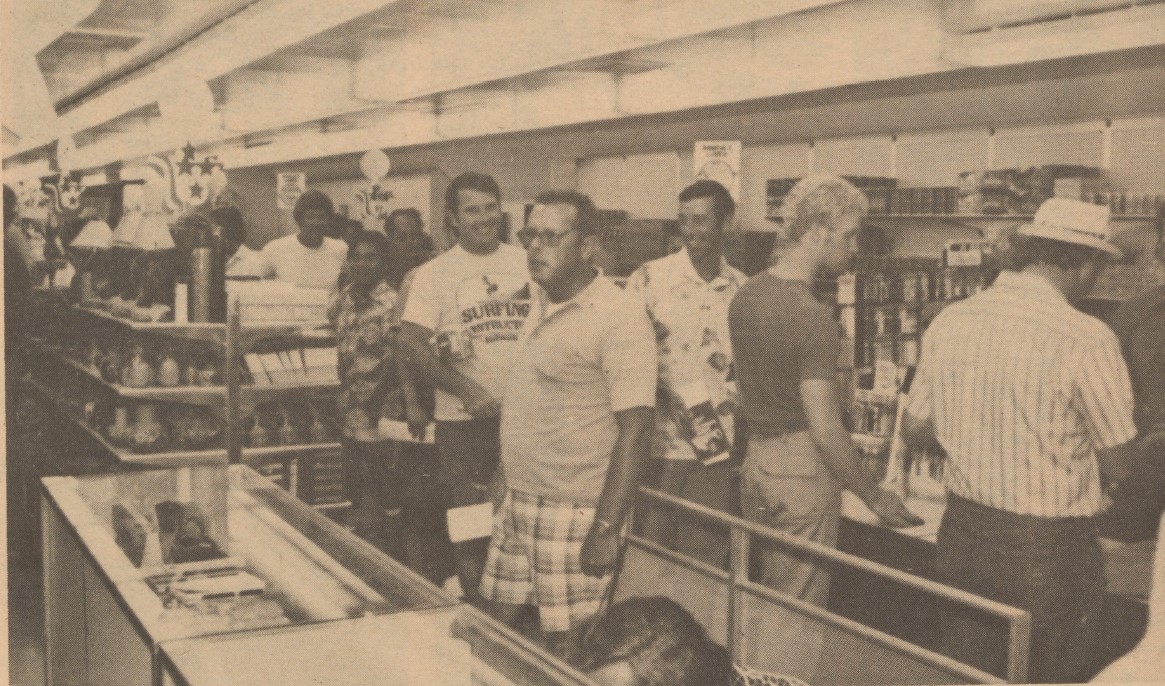#FlashbackFriday: 1977—A Unique Mission on Remote Islands in the Pacific

Updated March 5, 2025.
A unique—and brief—chapter in Exchange history began 48 years ago, in early 1977, when the Exchange opened stores on Enewetak and Lojwa islands, remote sites in the Enewetak Atoll in the Pacific Ocean.
Enewetak Atoll, about 2,700 miles west of Oahu, consists of 40 islands. In 1947, the atoll became a proving ground for nuclear weapons. Its 136 inhabitants at the time were relocated to Ujelang Atoll, about 125 miles to the southwest. Forty-three nuclear tests were conducted at Enewetak between April 1948 and July 1958.
By 1972, the Enewetak people, still at Ujelang, had grown to a population of more than 400 and wanted to return to their homeland, which offered more resources and land area than Ujelang.
Before they could return, the atoll had to be cleaned up and made safe for resettlement. Several hundred U.S. military and civilian personnel worked on the cleanup. At the request of the U.S. Defense Nuclear Agency, the Exchange opened the first of two retail stores on the island of Enewetak in early 1977.
Most of the island population was present to see Air Force Brig. Gen. Thomas E. Lacy, commander, Field Command, Defense Nuclear Agency (DNA), cut the ribbon at the grand opening, helped by COL Robert M. Sullivan Jr., AAFES-Pacific commander; William W. McEntire, executive, Hawaii Regional Exchange; and Douglas A. Logan, store manager.
Ronald Martin, Hawaii Regional Exchange retail branch operations manager, who along with Logan supervised store opening preparations for several weeks, called the opening “the biggest event on Enewetak since the last nuclear test.”(Martin was the last Exchange associate to be flown out of Vietnam in 1975.)
Before the opening, the Military Airlift Command flew in 179,000 pounds of assorted retail items for the store, which had 20,000 square feet of floor space, including its warehouse and two stockrooms.

Customers crowd the Enewetak Exchange shortly after its opening. The store, which was in a Quonset hut, was one of the only air-conditioned buildings on Enewetak Atoll.
Logan and Martin worked 16 to 18 hours a day to get the store ready. “Our greatest reward was that people would come in and look at the store as things were getting ready, Logan said, adding that the onlookers would say things such as, “Gee, it’s just like home.”
The Enewetak Island store initially had limited hours—4 to 6 p.m. daily except Sundays. Hours and expanded after more troops and workers arrived. Four U.S. Coast Guard members assisted at the store when they were available.
The cleanup of debris and hazards was expected to take approximately 28 months to complete. An advance party group of 50 Enewetak people was expected to move in mid-1977 to the noncontaminated island of Japtan, part of the atoll.
Later in 1977, a second store opened on Lojwa, another island in the atoll, about 17 miles from Enewetak. The Enewetak exchange was in a Quonset hut, while the Lojwa exchange was three trailers connected to one another, with one trailer used as a stockroom and housing for the manager.
“I was the first Lojwa PX Manager and I set up the PX Lojwa,” Ken Kasik said in an email to the Exchange Post after this story was published. “We started with one trailer when I arrived, then two, then three. As the island had limited housing, I decided to move into the store.”
The stores were popular not only because of the merchandise–they were also the only air conditioned buildings on the islands. Associates’ work attire was shorts and T-shirts. Along with heat, there were storms: In December 1977, 830 people were evacuated from the atoll to Guam during Typhoon Mary. Shortly after Martin returned to Enewetak to help returning store personnel, Tropical Storm Nancy blew through, tearing off part of the Enewetak BX’s roof and causing structural and water damage to other installations.
In April 1980, the DoD returned Enewetak atoll to the Enewetak people. In September 1980, the Exchange Post reported that both stores had closed.
“The live-in type situation for our managers dictated 24-hour on call duty,” Arthur L. Walker, Hawaii Area Exchange general manager, told the Exchange Post in 1980. “They were requested to open the stores at any time for. emergency purposes, or to handle service flight crews coming in.”
He added that because of the nature of the assignment, no family members were allowed to accompany the Exchange associates who managed the stores. “It wasn’t easy,” Walker said. “I’m sure our managers will agree that it was one of the roughest tours for any AAFES career employee.”
The Hawaii Exchange still includes remote locations: The Exchange has stores on Kwajalein Atoll, nearly 2,500 miles southwest of Oahu, and American Samoa, more than 2,200 miles southeast of Kwajalein.
Sources: Exchange Post archives; Enewetak Operation Fact Sheet, Defense Nuclear Agency, April 1980.





